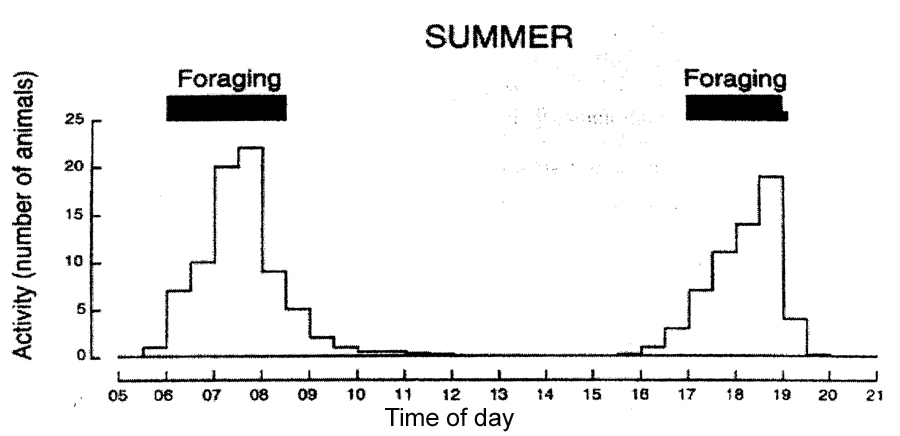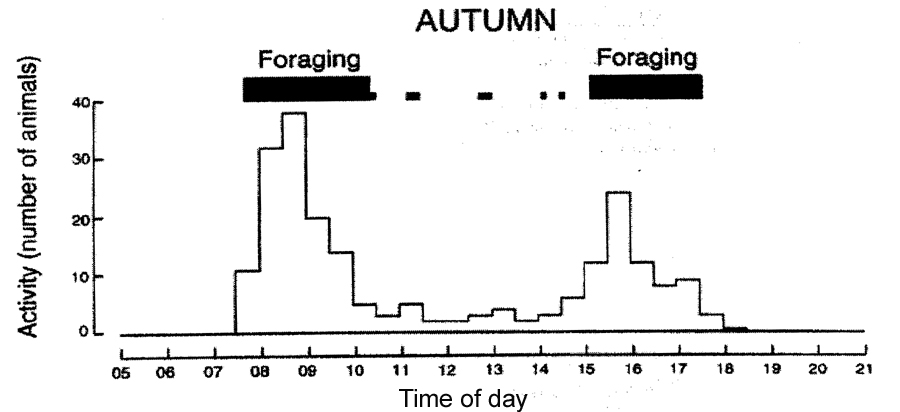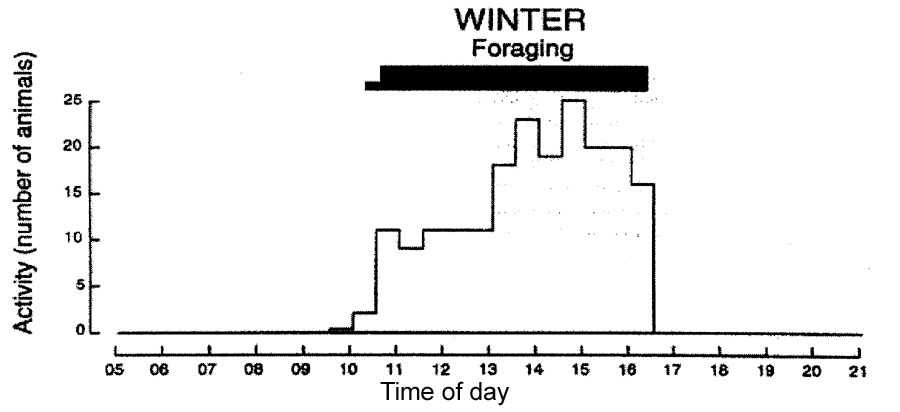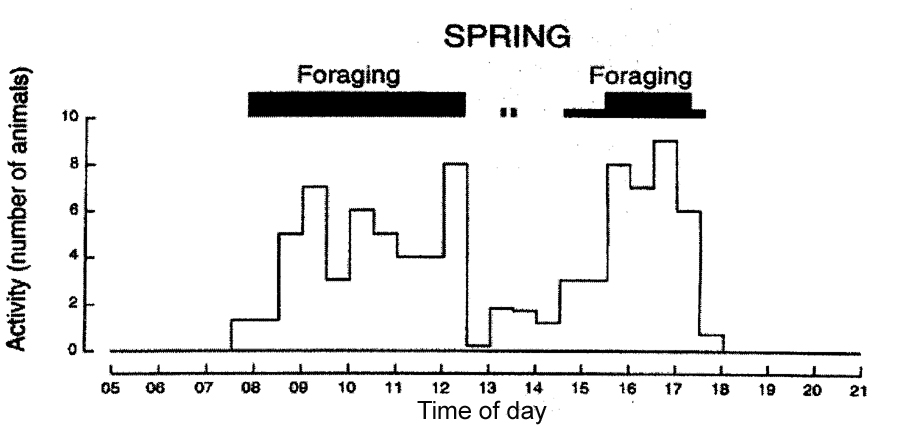Want to find out how degus live in the wild? Just read on! Ideally, your degu's life at home should have some similarities to their wild habitats in order for your degu to be happy. However, degus are very versatile and find adapting to new environments easier and less stressful than other mammals34.

>DIGGING<
Degus are semifossorial and live in elaborate burrows in the wild2
, 52
that they dig themselves. Degus prefer to dig in soft soil than in hard soil as they can dig out more soil using the same amount of energy2.
For this reason, degus prefer to dig their burrows in the winter when the soil is more moist2,
or after rainfall.
Degus use their teeth and front feet2
to shear soil when digging burrows, whilst combining rear and front foot motion2
to shift loose soil out behind them. Digging activity may be interrupted whilst the degu brings out large chunks of debris from the tunnel2,
after which the degu may sit on top of the excavated dirt mound and remain vigilant (watchful) for some time2.
Degus have also been observed breaking up the roof of tunnels with their head2.
However, degus are comparatively poorly adapted for digging as they have large eyes, long toes and nails instead of claws2.
Digging out burrows benefits the degus by providing increased independence from variable environmental factors2
(such as shelter from hot weather) and a place to hide from predators2.
It also provides a place to store food and to nest5
, 51.
However, digging out burrows uses a lot of the degu's energy and time5,
hence it is more beneficial to live in groups2.
Spending time underground in enclosed spaces has caused the degu to evolve unique responses to the lower oxygen levels and higher carbon dioxide concentration182.
Degu burrows have a diameter of 8-10 cm, are dug to a depth of 15-60 cm and may have a total length of 2 or more metres5!
The entrances are often covered with cow dung and sticks52.
Degu burrows are connected on the surface by a system of runways29
that radiate out from burrow entrances109;
bare patches of ground marked out by constant use29.
Degus will leave these runways only to forage or engage in social activities29.
Immediately outside the entrances to burrows are large areas of cleared land29
that degus use frequently to engage in behaviours such as agonistic encounters, play, social grooming, dust bathing, vigilance, resting and
burrow maintenance29.
>FEEDING<
Degus also spend much time on the surface, where they do most of their foraging for food2.
They spend between 5-6 hours per day foraging109.
The main activity peaks of foraging are at dawn and dusk11
, 52
, 109,
particularly in the summer when it is cooler to be on the surface at these times. At all times of year, degus begin foraging shortly after emerging
from their burrows109.
During the winter, degus will often forage only in the sun in order to reduce the cost of self-thermoregulation28.
Degus allocate most of their time budgets to foraging28
(see figures 1-4 below).
Vigilance is extremely important for foraging degus, as they need to be on the alert for predators at all times. Rather than organise the
foraging and vigilance duties, all female degus in a group will forage and be vigilant independently of one another, which suggests degus can both
forage and be vigilant to an extent at the same time163.
When a female degu cannot see another member of their group, however, their vigilance behaviour significantly increases163.
Degus will often collect food and store it in their burrows51
for winter consumption30
, 52,
but degus are active throughout the year11
and do not hibernate30
, 52
like some mammals. Degus have also been observed to collect food during the biphasic foraging times and store it in their burrows
for consumption during the less active periods11.
Degus use energy at different rates in different seasons28,
depending on their breeding season and changes in environmental conditions28
which change physiological demands. Energy expenditure increases during the breeding season28
so degus need to eat more, higher quality food at this time. Wild degus (male and female28)
have an average daily energy expenditure of 150 kJ day-1 in the breeding season28.
Energy expenditure in the Chilean summer is significantly lower than at other times of year28,
around 125 kJ day-1 28.
During times when degus may be very low on energy, they often supplement their food and water intake with coprophagy28
(faeces re-ingestion).
Wild degus' diet is nutritionally very poor12
(up to 60 % fibre in summer months155),
so degus must make up for this by increasing gut content volume12
, 155
(eating more), thus preventing them from losing weight. Wild degus therefore need to eat a lot more than your pet degu does.
It has been suggested that the availability of fibre and secondary compounds such as tannin (a brown chemical that also appears in tea) may
influence the wild degus' feeding and digestive strategies12.
Degus in a group will often have several designated feeding areas29.
Foraging (in summer) is carried out in specific areas with high densities of dried herbs and remaining green vegetation29.
Degus primarily eat green foliage of forbs and grasses during winter and spring and the green leaves of shrubs during summer and autumn32.
Degus also eat bark and seeds51
depending on availability.
During the annual drought, food becomes scarce and male and female degus loose weight to minimal body mass37.

^Figure 1- Activity pattern of wild degus in the Chilean summer.
Source: Kenagy, G., Nespolo, R., Vasquez, R. and Bozinovic, F. (2002) 'Daily and seasonal limits of time and temperature to activity of degus.' Revista Chilena de Historia Natural, 75: 567-581 (Ref: 109).

^Figure 2- Activity pattern of wild degus in the Chilean autumn.
Source: Kenagy, G., Nespolo, R., Vasquez, R. and Bozinovic, F. (2002) 'Daily and seasonal limits of time and temperature to activity of degus.' Revista Chilena de Historia Natural, 75: 567-581 (Ref: 109).

^Figure 3- Activity pattern of wild degus in the Chilean winter.
Source: Kenagy, G., Nespolo, R., Vasquez, R. and Bozinovic, F. (2002) 'Daily and seasonal limits of time and temperature to activity of degus.' Revista Chilena de Historia Natural, 75: 567-581 (Ref: 109).

^Figure 4- Activity pattern of wild degus in the Chilean spring.
Source: Kenagy, G., Nespolo, R., Vasquez, R. and Bozinovic, F. (2002) 'Daily and seasonal limits of time and temperature to activity of degus.' Revista Chilena de Historia Natural, 75: 567-581 (Ref: 109).
>ACTIVITY<
On average, a degu's day lasts from 09:00 hours to 16:00 hours2,
which are the hours of daylight (degus are diurnal) depending on the time of year; activity patterns differ conspicuously over the year109
(see figures 1-4 above). During the summer, degus emerge for around 3 hours after sunrise between temperatures of 10-47°C109.
They then retreat to their burrows for around 5 hours, emerging again later for around 2 hours before sunset after temperatures drop below 40°C109.
In autumn, morning foraging lasts around 3 hours after sunrise between temperatures of 10-45°C109.
Degus again return to their burrows for around 5 hours, emerging again for around 2 hours when temperatures are 40-20°C109.
In the winter, degus' activity switches from being bimodal to becoming unimodal147,
with degus emerging from their burrows for around 6 hours of the day between temperatures of 25-31°C109.
Spring activity becomes more bimodal with around 3 hours out of the burrows after sunrise when temperatures are 5-45°C109.
Burrow sheltering lasts around 2 hours after which the degus emerge again for around 2 hours before sunset at temperatures between 40-10°C109.
Degus are therefore able to change their daily activity pattern in response to day length and/or environmental heat load109.
Such temporal shifts involve trade-offs based on heat exposure and forage requirements147.
Although degus are classed as diurnal109
(awake during the day), during the summer wild degus show increased surface activity at dawn and dusk6
(termed 'biphasic' or 'cepuscular'143),
due to the rise in temperature at midday109.
Research has shown that degus can invert their circadian rhythms (become nocturnal) in response to environmental changes6.
Such changes could include predation variety, changes in food availability and temperature changes6.
Inversion in these cases would promote survival of the degus6
as they are able to adapt to changes.
This adaptability has
been demonstrated in the degus body temperature. In
to other small mammals, degus do not show significant circadian rhythmicity of
62.
These would normally be controlled by circadian oscillatory processes in the
suprachiasmatic nuclei of the hypothalamus in the brain62.
The
for degu body temperature appears flat with low spectral energy, demonstrating
another feature that allows the degu to adapt to a variety of environmental
conditions.
>PREDATION<
Degus in the wild are also a food source for some animals (I know, but try not to think about it too much!). They are most frequently preyed upon by
raptors5,
black-chested buzzards19
, 52 ,
barn owls52 ,
short-eared owls52
and culpeo foxes5
, 19 .
Historic archaeological data has even shown humans have hunted and eaten degus in the recent past19!!
Degus are always on the lookout for predators when outside their burrows. An alarmed degu will always flee into or remain near the closest
burrow entrance5.
They will also give a characteristic alarm call which alerts other degus to possible danger that are within an audible range5.
Degus in larger groups often detect predators at a greater distance than degus in smaller groups19
as there are more pairs of eyes on the lookout. This is why exposed areas of Chile have larger degu groups (degus perceive higher predation risk in
open areas29),
as there are less places for degus to hide thus allowing degus to escape to burrows sooner than degus living in smaller groups19
which may not spot a predator so quickly. Another anti-predatory advantage of larger groups is that a conspecific individual is less likely to be
picked off by a predator19
than if the predator has only a choice of a couple of degus ('safety in numbers'). This will also have slightly less of a detrimental effect on the
group as a whole, and more degus mean more of a chance of successfully defending or fighting off an intruder19.
Other vigilance benefits of larger groups include that any one individual degu can spend less time looking for predators and more time foraging for food156,
enhancing fitness indirectly.
Degus in the open often move in 'bursts', frequently stopping and starting. Degus stop not only to look for predators, but also as it is far harder for
a predator to spot a motionless (as opposed to a moving) degu29.
Degus on the move don't run at full speed29,
instead they reserve their aerobic speed for times when they may need it most29,
such as escaping from a predator.
Wild degus will suspect that anything new to their environment is a potential predator and be wary of it, so view humans as predators19
too. Because of the threat of predators, when a degu first comes to the surface to forage it will spend some time remaining vigilant beside its
burrow entrance. Degus that live in open habitats will spend more time being vigilant19
as they will be more vulnerable to predation and have fewer places to hide.
Degus' brown fur means they are camouflaged in their natural habitat24.
Having UV reflective bellies can act a a good signal to other degus, but is difficult to spot by a predator from above as most of the surrounding
environment is non-UV reflecting24.
This is critical to survival of degus as many aerial predators can see in UV24.
If a degu is captured by its tail, the skin near the base of the tail will tear off30
, 52.
Later, the degu will chew off the exposed bone at a narrowing of the vertebrae so to minimise blood loss30.
The tail will not grow back30.
Wild degus are frequently seen to have portions of the tail missing52.
>DUST-BATHING<
Other surface activities that degus regularly perform include dustbathing. Dustbathing helps keep the degus fur free of oil22 and dirt and prevents parasite infection. Regulating the fur's oil secretion is vital in maintaining thermoregulatory efficiency of the degu's body22 (allows the degu to keep cool effectively). During dustbathing, a degu will dig briefly into the ground with its forepaws and then rub its sides and belly in the dust22. Degus will usually rub their right and left sides alternately in the sand22. This process is a type of 'fixed action pattern', which is innate to degus (known from birth), although the substrate in which degus can perform the bathing routine appears to have to be learnt*. Dustbathing is also a form of social communication22 (see community section) and degus will dustbathe in sites that are frequently urine marked22, particularly outside the entrance to their burrows to signify ownership22.
>TERRITORY<
Given that degus live in relatively small groups, it has been shown that they also inhabit comparatively small areas of land, on average 0.04-0.71 hectares28 (about 400-7,100 m2).